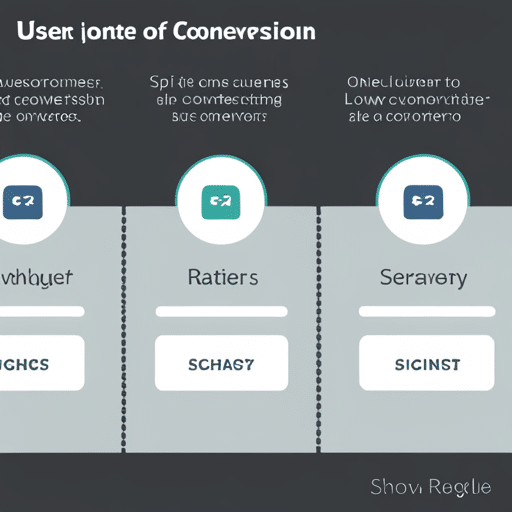Table Of Contents
If you’ve ever wondered why your website isn’t converting as well as it could, look no further. This guide is here to unlock the secrets of user behavior and help you optimize your conversion rate.
By understanding how users interact with your site, analyzing data, and implementing proven strategies, you can improve user experience and drive higher conversions.
From optimizing landing pages to testing and measuring success, this comprehensive guide will equip you with the tools you need for conversion rate optimization success.
Key Takeaways
– Understanding user psychology is crucial for improving conversion rates.
– Analyzing user behavior helps identify patterns, trends, and pain points in the user journey.
– Optimizing landing pages with compelling headlines, clear value propositions, and optimized call-to-action buttons can significantly impact conversion rates.
– Testing different elements of landing pages, such as headlines and call-to-action buttons, provides insights into conversion rate optimization.
The Importance of Understanding User Behavior

Understanding user behavior is crucial for improving conversion rates. By delving into user psychology and utilizing behavior tracking, businesses can gain valuable insights that inform their optimization efforts.
User psychology involves understanding the motivations, needs, and preferences that drive users to take certain actions or make specific decisions. Businesses can identify patterns, trends, and pain points in the user journey by analyzing user behavior through data-driven methods such as behavior tracking. This enables them to make informed changes to their website design, layout, content, and overall user experience.
Behavior tracking allows businesses to monitor metrics like click-through rates, bounce rates, time spent on page, and conversion rates. Armed with this knowledge, businesses can then implement targeted strategies aimed at increasing conversions by addressing specific user behaviors or barriers to conversion.
Analyzing Data for Conversion Rate Optimization

Analyzing data is essential for improving conversion rates. To optimize your website’s conversion rate, you must understand how users interact with your site and identify any barriers preventing them from converting.
By analyzing user journeys, you can gain valuable insights into their behavior and preferences.
Start by examining the different stages of the user journey, from landing on your website to completing a desired action. Look for patterns and trends in the data to understand where users drop off or get stuck. This will help you identify potential conversion barriers such as complicated checkout processes or unclear calls-to-action.
Additionally, analyze demographic information and user engagement metrics to better understand who your target audience is and how they engage with your site. This data-driven approach will enable you to make informed decisions when optimizing your website for improved conversion rates.
Strategies to Improve User Experience

To improve your website’s user experience, focus on implementing strategies that prioritize ease of navigation and intuitive design. By incorporating personalization techniques for a better user experience and following user interface design principles for improved usability, you can enhance the overall satisfaction of your visitors.
Consider the following strategies:
– Utilize personalized recommendations based on user behavior to enhance engagement and increase conversions.
– Ensure clear and concise labeling of navigation elements to make it easy for users to find what they’re looking for.
– Optimize page load times to reduce frustration and increase retention.
– Implement responsive design to ensure a seamless experience across different devices.
Optimizing Landing Pages for Higher Conversions

When optimizing your landing pages for higher conversions, focus on creating compelling headlines that grab the attention of your visitors. The first impression is crucial in capturing their interest and encouraging them to take action.
To maximize conversion rates, it’s essential to optimize both the conversion funnel and call to action (CTA) elements on your landing page.
Conversion funnel optimization involves streamlining the user journey from initial visit to final conversion. Analyze data on user behavior, identify potential drop-off points, and make necessary adjustments to improve the flow. Simplifying forms, reducing distractions, and providing clear value propositions can all contribute to a smoother conversion process.
Additionally, optimizing your call to action buttons is vital for driving conversions. Use concise and actionable language that clearly communicates what users can expect when they click. Experiment with different button colors, sizes, and placements to find what works best for your audience.
Testing and Measuring Success in Conversion Rate Optimization

You can start testing different elements of your landing pages to measure the success of your conversion rate optimization efforts. By using effective testing techniques such as A/B testing, you can gain valuable insights into what works and what doesn’t when it comes to converting visitors into customers.
Here are some key points to consider:
– Test different headlines: Try out various headlines to see which ones resonate best with your audience and lead to higher conversions.
– Experiment with call-to-action buttons: Changing the color, size, or wording of your call-to-action buttons can have a significant impact on conversion rates.
– Vary the layout and design: Altering the placement of images, text blocks, and forms can help identify the most optimal arrangement for maximum conversions.
– Analyze user behavior through heatmaps: Heatmaps provide visual representations of how users interact with your landing page, revealing areas that need improvement.


